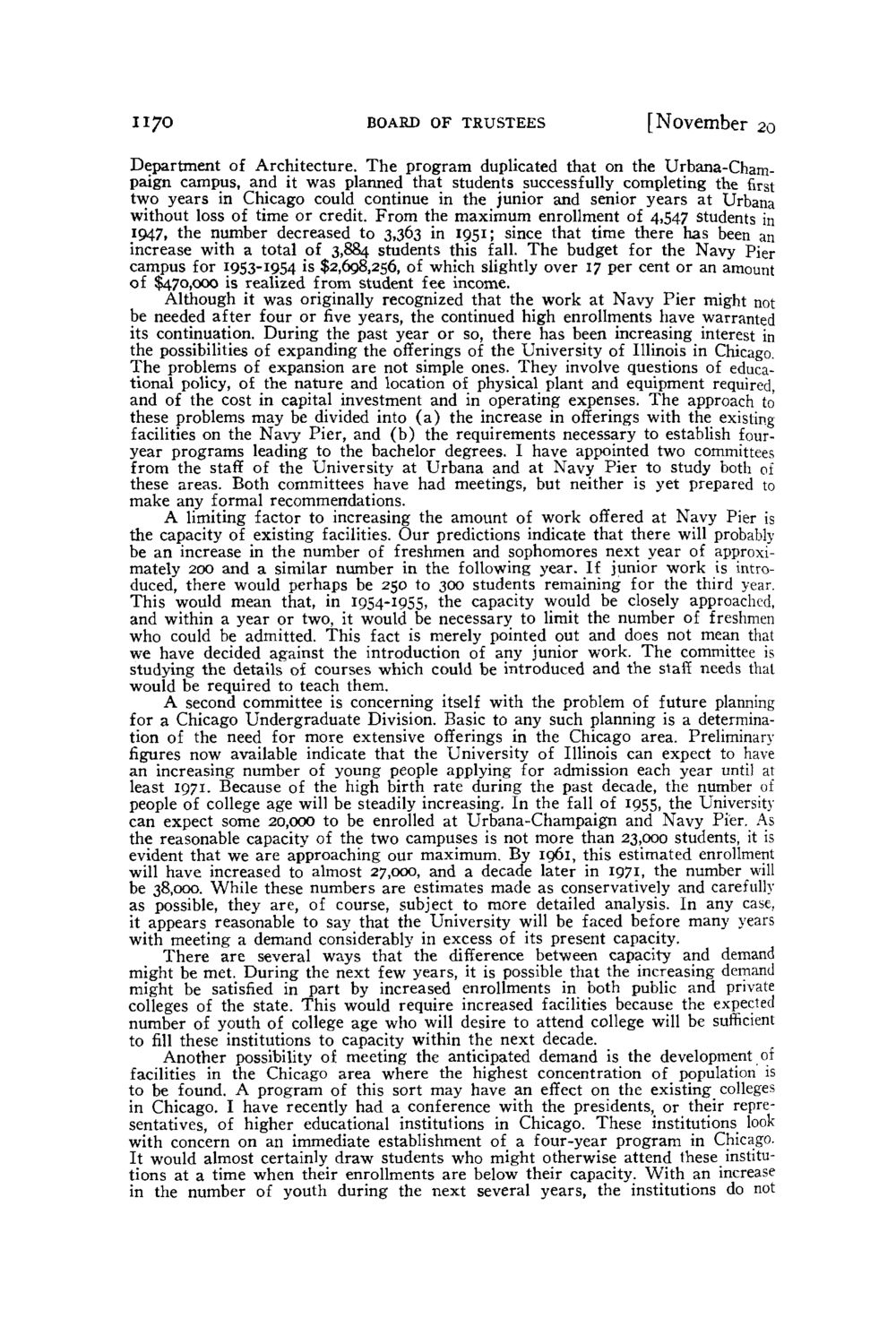| |
| |
Caption: Board of Trustees Minutes - 1954
This is a reduced-resolution page image for fast online browsing.

EXTRACTED TEXT FROM PAGE:
1170 BOARD OF TRUSTEES [November 20 Department of Architecture. T h e program duplicated that on the Urbana-Champaign campus, and it was planned that students successfully completing the first two years in Chicago could continue in the junior and senior years at Urbana without loss of time or credit. From the maximum enrollment of 4,547 students in 1947, the number decreased to 3,363 in 1951; since that time there has been an increase with a total of 3,884 students this fall. The budget for the Navy Pier campus for I9S3-I954 is $2,698,256, of which slightly over 17 per cent or an amount of $470,000 is realized from student fee income. Although it was originally recognized that the work at Navy Pier might not be needed after four or five years, the continued high enrollments have warranted its continuation. During the past year or so, there has been increasing interest in the possibilities of expanding the offerings of the University of Illinois in Chicago. The problems of expansion are not simple ones. They involve questions of educational policy, of the nature and location of physical plant and equipment required, and of the cost in capital investment and in operating expenses. The approach to these problems may be divided into ( a ) the increase in offerings with the existing facilities on the Navy Pier, and (b) the requirements necessary to establish fouryear programs leading to the bachelor degrees. I have appointed two committees from the staff of the University at Urbana and at Navy Pier to study both of these areas. Both committees have had meetings, but neither is yet prepared to make any formal recommendations. A limiting factor to increasing the amount of work offered at Navy Pier is the capacity of existing facilities. Our predictions indicate that there will probably be an increase in the number of freshmen and sophomores next year of approximately 200 and a similar number in the following year. If junior work is introduced, there would perhaps be 250 to 300 students remaining for the third year. This would mean that, in 1954-1955, the capacity would be closely approached, and within a year or two, it would be necessary to limit the number of freshmen who could be admitted. This fact is merely pointed out and does not mean that we have decided against the introduction of any junior work. The committee is studying the details of courses which could be introduced and the staff needs that would be required to teach them. A second committee is concerning itself with the problem of future planning for a Chicago Undergraduate Division. Basic to any such planning is a determination of the need for more extensive offerings in the Chicago area. Preliminary figures now available indicate that the University of Illinois can expect to have an increasing number of young people applying for admission each year until at least 1971. Because of the high birth rate during the past decade, the number of people of college age will be steadily increasing. In the fall of 1955, the University can expect some 20,000 to be enrolled at Urbana-Champaign and Navy Pier. As the reasonable capacity of the two campuses is not more than 23,000 students, it is evident that we are approaching our maximum. By 1061, this estimated enrollment will have increased to almost 27,000, and a decade later in 1971, the number will be 38,000. While these numbers are estimates made as conservatively and carefully as possible, they are, of course, subject to more detailed analysis. In any case, it appears reasonable to say that the University will be faced before many years with meeting a demand considerably in excess of its present capacity. There are several ways that the difference between capacity and demand might be met. During the next few years, it is possible that the increasing demand might be satisfied in part by increased enrollments in both public and private colleges of the state. This would require increased facilities because the expected number of youth of college age who will desire to attend college will be sufficient to fill these institutions to capacity within the next decade. Another possibility of meeting the anticipated demand is the development of facilities in the Chicago area where the highest concentration of population is to be found. A program of this sort may have an effect on the existing colleges in Chicago. I have recently had a conference with the presidents, or their representatives, of higher educational institutions in Chicago. These institutions look with concern on an immediate establishment of a four-year program in Chicago. It would almost certainly draw students who might otherwise attend these institutions at a time when their enrollments are below their capacity. With an increase in the number of youth during the next several years, the institutions do not
| |